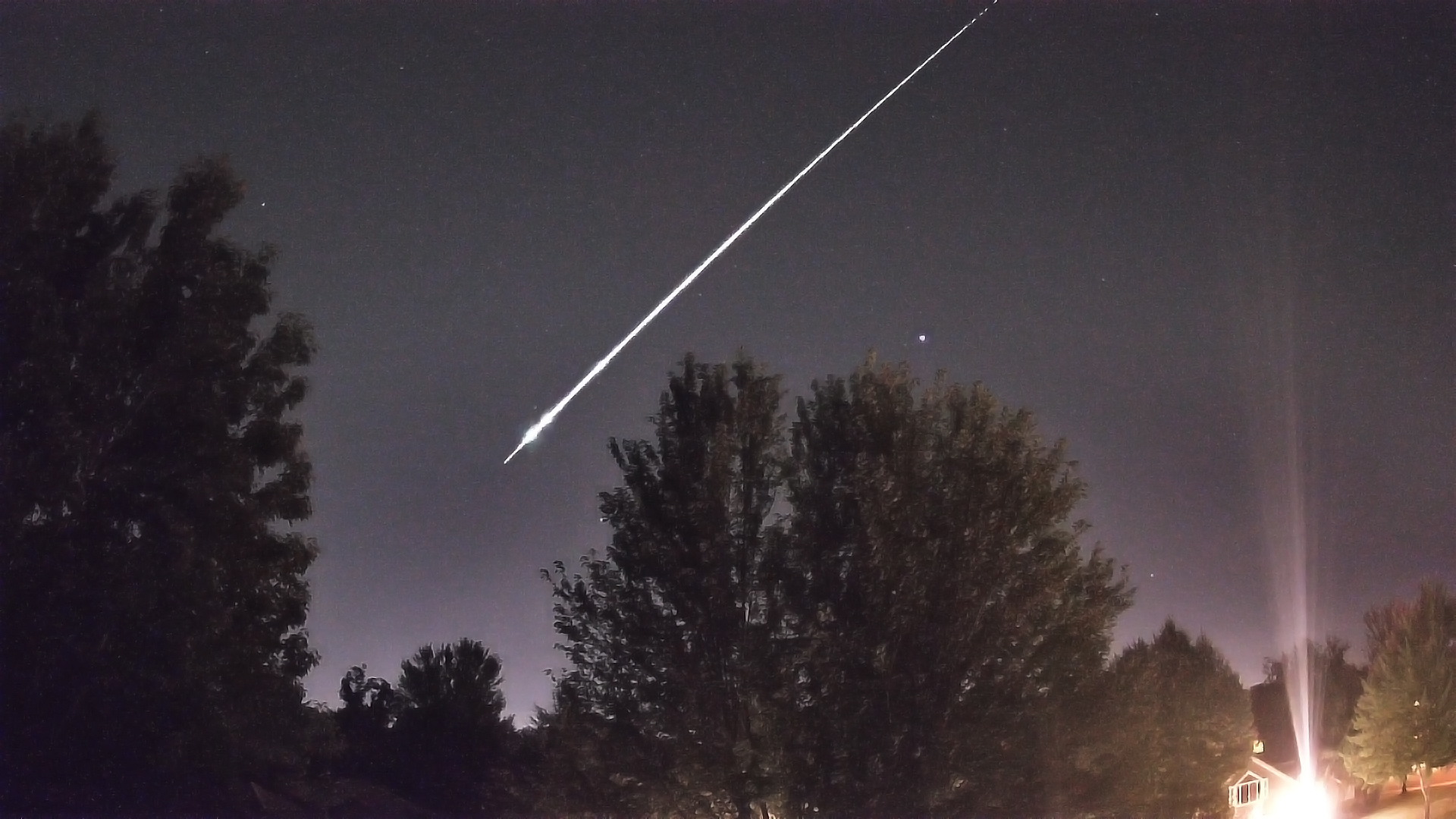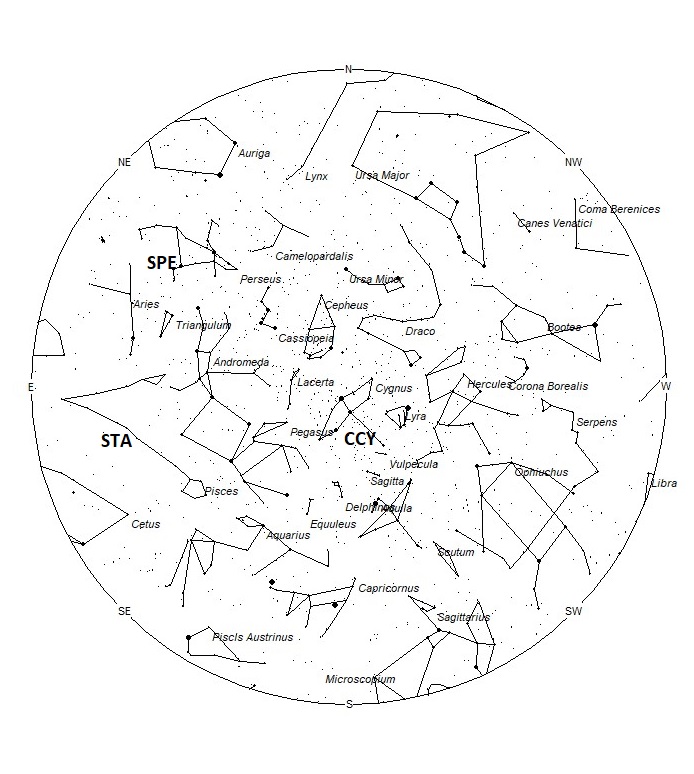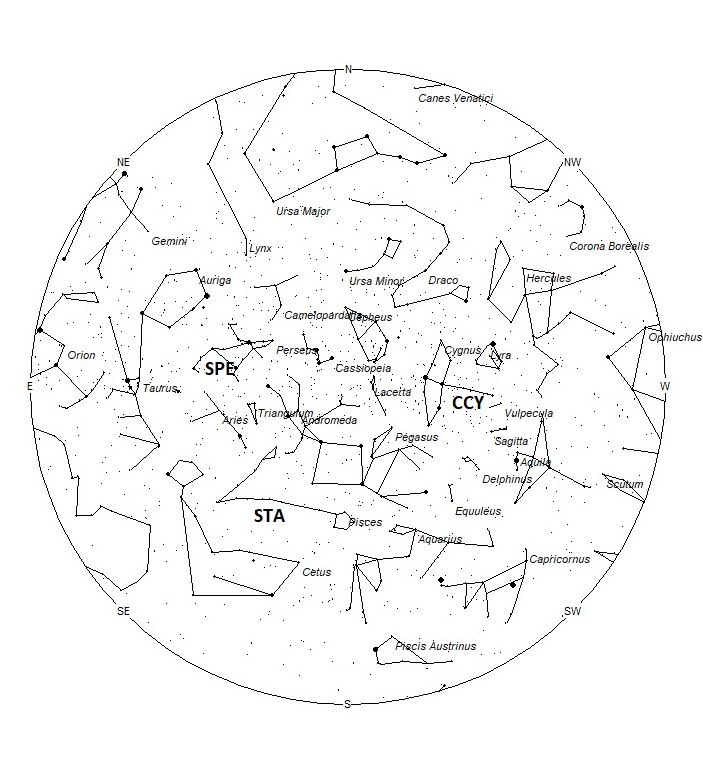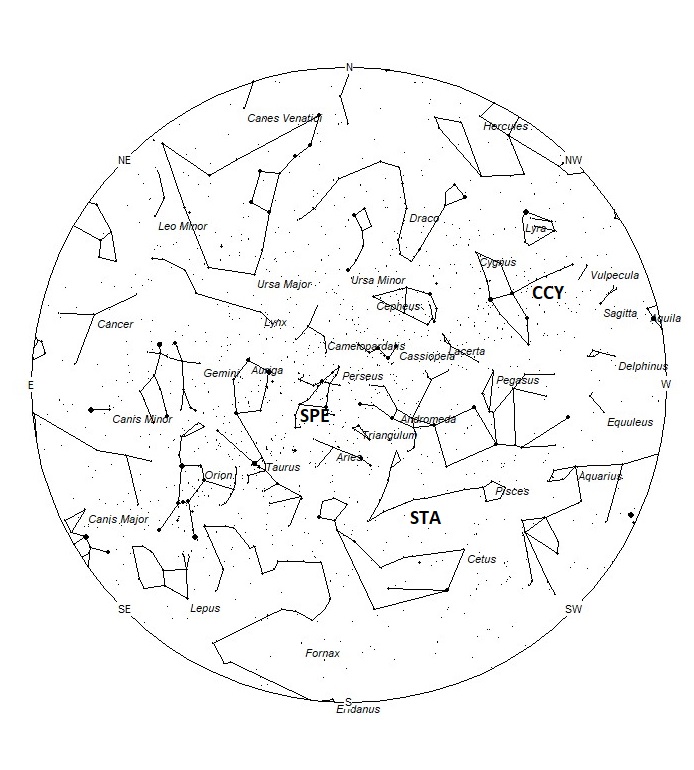
During this period, the moon reaches its first quarter phase on Monday September 13th. At that time the moon lies 90 degrees east of the sun and sets near 23:00 local summer time (LST). This weekend the waxing crescent moon will set during the late evening hours and will not interfere with meteor observing during the more active morning hours. The estimated total hourly meteor rates for evening observers this week is near 3 as seen from mid-northern latitudes (45N) and 2 as seen from tropical southern locations (25S). For morning observers, the estimated total hourly rates should be near 14 as seen from mid-northern latitudes (45N) and 11 as seen from tropical southern locations (25S). The actual rates will also depend on factors such as personal light and motion perception, local weather conditions, alertness, and experience in watching meteor activity. Evening rates are reduced due to moonlight. Note that the hourly rates listed below are estimates as viewed from dark sky sites away from urban light sources. Observers viewing from urban areas will see less activity as only the brighter meteors will be visible from such locations.
The radiant (the area of the sky where meteors appear to shoot from) positions and rates listed below are exact for Saturday night/Sunday morning September 11/12. These positions do not change greatly day to day so the listed coordinates may be used during this entire period. Most star atlases (available at science stores and planetariums) will provide maps with grid lines of the celestial coordinates so that you may find out exactly where these positions are located in the sky. I have also included charts of the sky that display the radiant positions for evening, midnight, and morning. The center of each chart is the sky directly overhead at the appropriate hour. These charts are oriented for facing south but can be used for any direction by rotating the charts to the desired direction. A planisphere or computer planetarium program is also useful in showing the sky at any time of night on any date of the year. Activity from each radiant is best seen when it is positioned highest in the sky, either due north or south along the meridian, depending on your latitude. It must be remembered that meteor activity is rarely seen at the radiant position. Rather they shoot outwards from the radiant, so it is best to center your field of view so that the radiant lies at the edge and not the center. Viewing there will allow you to easily trace the path of each meteor back to the radiant (if it is a shower member) or in another direction if it is sporadic. Meteor activity is not seen from radiants that are located far below the horizon. The positions below are listed in a west to east manner in order of right ascension (celestial longitude). The positions listed first are located further west therefore are accessible earlier in the night while those listed further down the list rise later in the night.
These sources of meteoric activity are expected to be active this week.
.
The chi Cygnids (CCY) were discovered on the night of 14/15 September 2015, when a weak outburst of meteors occurred where none had been observed before. Since then, little activity has been detected until August of 2020, when another mini outburst of possible CCY activity occurred south of the normal radiant between the constellations of Delphinus and Aquila. Some astronomers believe this early appearance may herald another return of the CCY’s from their normal radiant in southern Cygnus. Nothing unusual occurred in September but activity from this source should be monitored, nonetheless. The most probable dates of this occurring would be on the nights from September 13-15. At that time the radiant should be located near 20:00 (300) +31, a position 3 degrees southeast of the variable star chi Cygni. An easier method of locating the radiant would be to draw an imaginary line from the bright stars Albireo (beta Cygni) to Aljanah (epsilon Cygni). The radiant lies just short of the half-way point of this line. These meteors can be seen all night long but are best seen near 20:00 Local Standard Time (LST) when the radiant lies nearly overhead as seen from the northern hemisphere. Rates are expected to be low but anyone seeing any of these meteors should report them to the International Meteor Organization on an online visual meteor report form. With an entry velocity of 19 km/sec., the average meteor from this source would be of very slow velocity. Unfortunately, these meteors are not well seen from southern hemisphere as Cygnus does not rise high into the sky from those locations.
We are now encountering inbound debris from comet 2P/Encke, which has its source superimposed upon the anthelion radiant. Since it has been shown that meteors from 2P/Encke are more numerous than the anthelions, we will recognize this activity as the Southern Taurids (STA). Like the anthelion radiant, the source area is large and diffuse so observers can be liberal with the shower association of these meteors. The southern Taurids are active for three months and reach maximum activity on October 10th. The current position of the STA radiant lies at 00:52 (013) +03, which places it in southern Pisces, 4 degrees south of the 4th magnitude star known as delta Piscium. The radiant is best placed near 0200 LST, when it lies highest above the horizon. Rates are expected to be near 2 no matter your location. With an entry velocity of 27 km/sec., most activity from this radiant would be slow moving.
The September epsilon Perseids (SPE) are active from September 2-23, with maximum activity occurring on the 9th. The current position of the radiant lies at 03:20 (050) +40. This area of the sky lies in southwestern Perseus, 2 degrees southeast of famous eclipsing binary star known as Algol (beta Persei). This radiant is best placed near 0200 LST, when it lies on the meridian and is located highest in the sky. Rates at this time should be near 1 per hour as seen from the Northern Hemisphere and less than 1 as seen from south of the equator. For observers in the Northern Hemisphere, rates should increase to near 3 per hour on September 9th. There have been outbursts from this source in the past, but none are predicted for this year. With an entry velocity of 64 km/sec., the average meteor would be of swift velocity.
As seen from the mid-northern hemisphere (45N) one would expect to see approximately 11 sporadic meteors per hour during the last hour before dawn as seen from rural observing sites. Evening rates would be near 2 per hour. As seen from the tropical southern latitudes (25S), morning rates would be near 7 per hour as seen from rural observing sites and 1 per hour during the evening hours. Locations between these two extremes would see activity between the listed figures. Evening rates are reduced due to interfering moonlight.
|
SHOWER |
DATE OF MAXIMUM ACTIVITY | CELESTIAL POSITION | ENTRY VELOCITY | CULMINATION | HOURLY RATE | CLASS |
| RA (RA in Deg.) DEC | Km/Sec | Local Summer Time | North-South | |||
| chi Cygnids (CCY) | Sep 15 | 20:00 (300) +31 | 19 | 22:00 | <1 – <1 | IV |
| Southern Taurids (STA) | Oct 10 | 00:52 (013) +03 | 27 | 02:00 | 2 – 2 | II |
| September epsilon Perseids (SPE) | Sep 09 | 03:20 (050) +40 | 64 | 05:00 | 1 – <1 | II |







 You saw something bright and fast? Like a huge shooting star? Report it: it may be a fireball.
You saw something bright and fast? Like a huge shooting star? Report it: it may be a fireball.  You counted meteors last night? Share your results with us!
You counted meteors last night? Share your results with us!  You took a photo of a meteor or fireball? You have a screenshot of your cam? Share it with us!
You took a photo of a meteor or fireball? You have a screenshot of your cam? Share it with us!  You caught a meteor or fireball on video? Share your video with us!
You caught a meteor or fireball on video? Share your video with us!